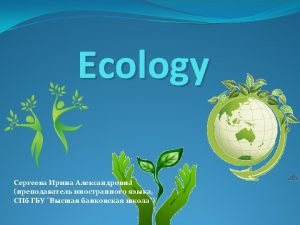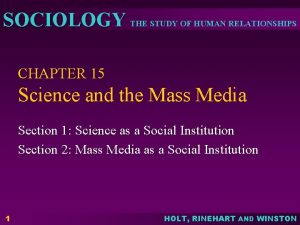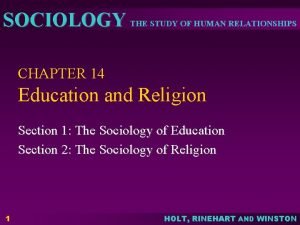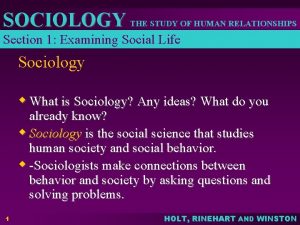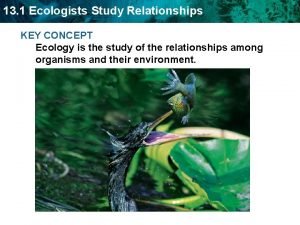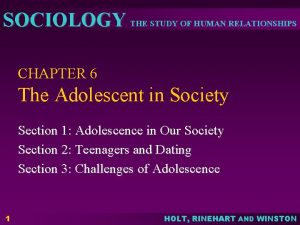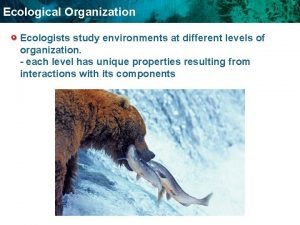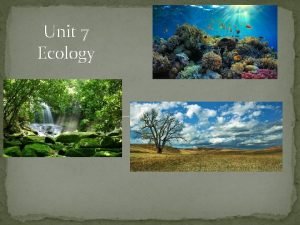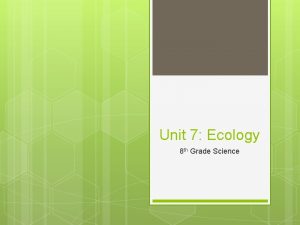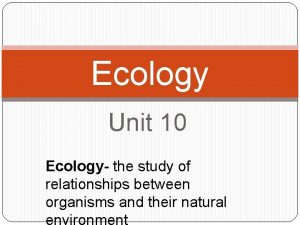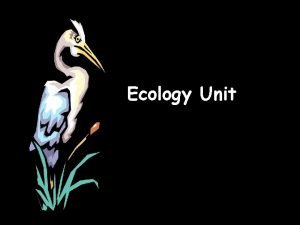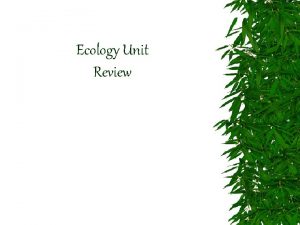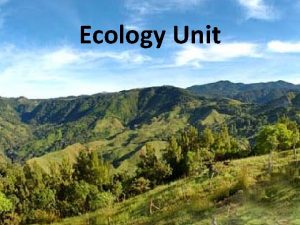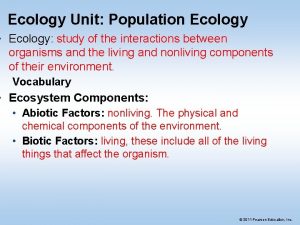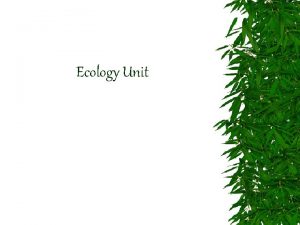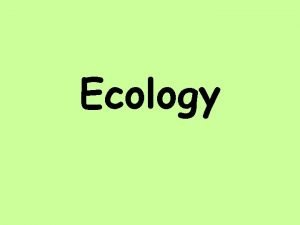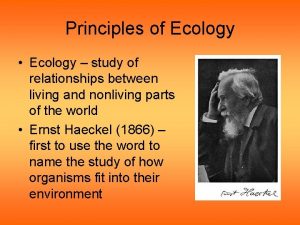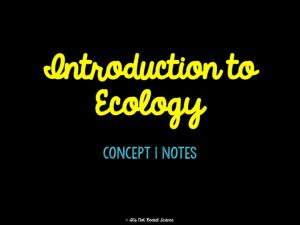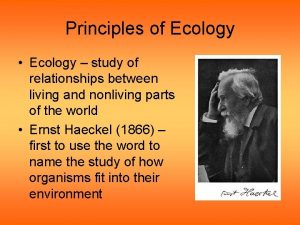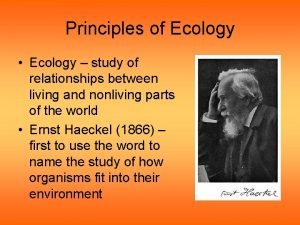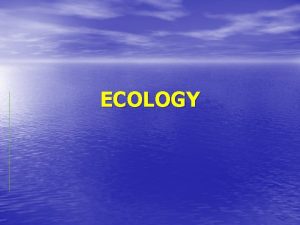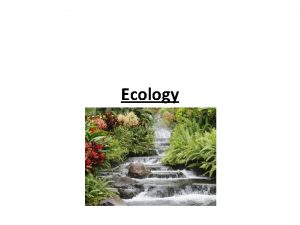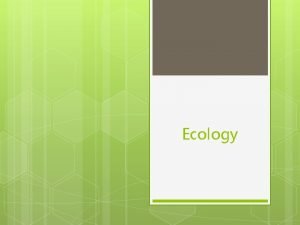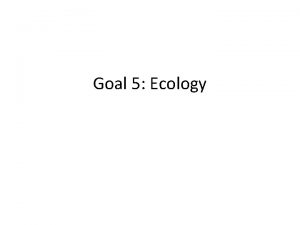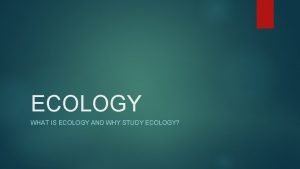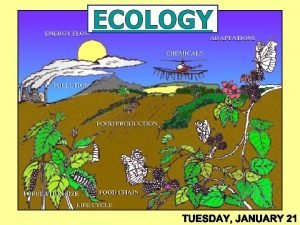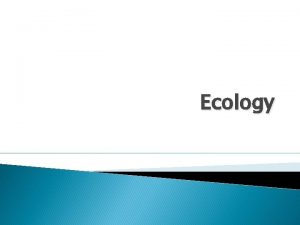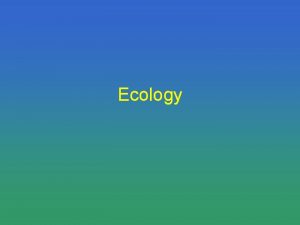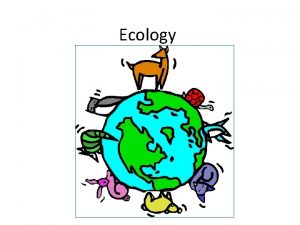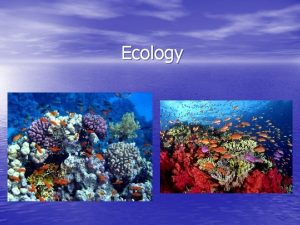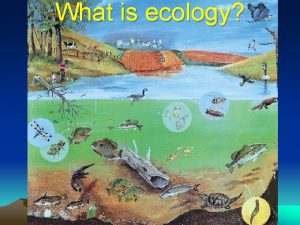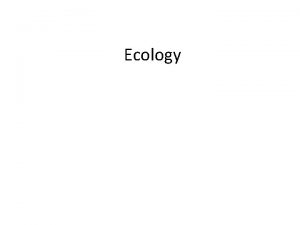Ecology Unit 10 Ecology the study of relationships




























- Slides: 28

Ecology Unit 10 Ecology- the study of relationships between organisms and their natural

Ecosystem- collection of all the organisms that live in a particular place together with their nonliving environment Habitat- the area where an organism lives Community- assortment of populations that live together in a specific place Population- a group of organisms of the same species living in the same area Individual

�Obj. 1: Explain why two species cannot occupy the same niche in a community. Niche- the role an organism plays in its environment Honey bees will pollinate a large variety of plants. Honey is stored in the honeycomb by bees as a food source for the colony in cold months. Worker bees secrete beeswax they use to form the walls and caps of the comb. Honey bees are natively found in South and South East Asia and many subspecies reside all over the world. In cold climates honey bees stop flying when the temperature drops below about 50 °F and crowd into the central area of the hive to form a "winter cluster. " All honey bees live in colonies where the worker bees will sting intruders as a form of defense, and alarmed bees will release a pheromone that stimulates the attack response in other

�Components of the honeybee niche: �Pollinate flowers �Store honey �Secrete beeswax to make honeycomb �Live in southern Asia and other places around the world �Crowd around each other during cold months �Worker bees defend the hive

Obj 2: Identify and describe symbiotic relationships and explain their importance in food webs and ecosystems. �Symbiosis- relationship in which two species lives closely together

Symbiotic Relationship Commensalism Mutualism Parasitism Definition symbiotic relationship in which one member benefits and the other is neither helped nor symbiotic harmed in relationship which both members benefit symbiotic relationship in which one member benefits and the other is harmed Organism 1 Organism 2 + 0 + + + -

Obj. 3: Describe predator/prey relationships.

Obj. 4: Predict how the use and flow of energy will be altered due to changes in a food web. �Producer- organisms that are able to make their own energy from inorganic molecules (exsunlight, chemicals) Consumer- any organism that feeds on other organisms Primary Consumer- first level consumer, eats producers Herbivore- an organism that only eats plants

Secondary Consumer- second level consumer Tertiary Consumer- third level consumer Omnivore- an organism that eats both plants and animals Carnivore- an organism that only eats animals

�Food Web- network of interactions formed by feeding relationships among organisms in an ecosystem �Circle the producers �Put a square around the consumers and label them 1, 2, and/or 3 for primary, secondary, or tertiary

Interpreting a Food Web �Components: �Organisms: linked to other animals based on what it consumes/what consumes it �Arrows: show the direction of energy flow �Stability: the more connections (arrows) between various organisms, the more stable a food web is. �Simple: dependence on very few organisms, few interactions within the community �Complex: distribution of dependence on a variety of organisms, many interactions between the organisms of the community

Stable or Unstable? Simple or Complex?

�Energy pyramid- diagram that shows the transfer of energy through levels in a food chain 10% Rule- only 10% of energy is transferred from one level to another

Obj. 5: Identify abiotic and biotic limiting factors and their effects on growth in ecosystems. �Abiotic- non-living components of an environment �Biotic- living components of an environment

Obj 6: Explain how the carrying capacity of a species is the population size that an ecosystem can sustain based on available resources. �Carrying capacity- largest number of individuals in a population that an environment can support �Limiting factor- factor that causes the growth of a population to decrease or stabilize �Biotic potential- maximum reproductive capacity of a population with unlimited resources


Obj. 7: Explain the processes and importance involved in the cycling of water, nitrogen, oxygen, and carbon through an ecosystem.

The Water Cycle

Evaporation water changes from a liquid to a gas (vapor) Condensation water vapor in the air is changed into liquid water (this is how clouds are formed) Precipitation water released from clouds (rain, freezing rain, sleet, snow, or hail) Transpiration loss of water from a plant through its leaves

The Carbon Cycle

�http: //www. pbs. org/teachers/connec t/resources/6558/preview/

�All living things are composed of carbon �Plants use carbon dioxide and sunlight to do photosynthesis �Carbon also becomes a part of the animals who eat these plants �Carbon returns to the atmosphere by plant and animal cellular respiration �Carbon also returns to the atmosphere by dead organisms and wastes

The Oxygen Cycle

�Photosynthesis adds O 2. �Cellular respiration removes O 2 from the air �Connected to the Carbon cycle

The Nitrogen Cycle �Nitrogen is used by living organisms to produce a number of complex organic molecules like amino acids, proteins, and nucleic acids.

�Nitrogen Fixation �Process of converting nitrogen gas into ammonia �By bacteria �By lightning �Nitrification �The process of changing ammonia to nitrates. �By bacteria �Denitrification � Conversion of nitrates into nitrogen gas. �By bacteria.

Humans and the Nitrogen Cycle �Nitrogen fertilizers �The additional nitrogen entering the groundwater system eventually flows into streams, rivers, lakes, and estuaries. �Livestock ranching. � Livestock release a large amounts of ammonia into the environment from their wastes. This nitrogen enters the soil system and then the water cycle through leaching, groundwater flow, and runoff.

Obj 8: Explain how some pollutants are biologically magnified in food webs. �Biological magnification- process by which toxins become more concentrated in each link of the food chain
 Principles of ecology chapter 2 section 3 answer key
Principles of ecology chapter 2 section 3 answer key Principles of ecology organisms and their relationships
Principles of ecology organisms and their relationships Biology ecology study guide answer key
Biology ecology study guide answer key Chapter 3 section 1: community ecology answer key
Chapter 3 section 1: community ecology answer key Ecology is the study that helps to preserve
Ecology is the study that helps to preserve Unit 10, unit 10 review tests, unit 10 general test
Unit 10, unit 10 review tests, unit 10 general test Sociology the study of human relationships
Sociology the study of human relationships Sociology the study of human relationships
Sociology the study of human relationships Conflict theory
Conflict theory Section 1 ecologists study relationships
Section 1 ecologists study relationships Sociology the study of human relationships
Sociology the study of human relationships Ecological organization levels
Ecological organization levels Unit 7 ecology
Unit 7 ecology Unit 7 ecology answer key
Unit 7 ecology answer key Unit 5 ecology
Unit 5 ecology Biological magnification
Biological magnification Ecology unit review
Ecology unit review Sulfur oxide
Sulfur oxide Hát kết hợp bộ gõ cơ thể
Hát kết hợp bộ gõ cơ thể Ng-html
Ng-html Bổ thể
Bổ thể Tỉ lệ cơ thể trẻ em
Tỉ lệ cơ thể trẻ em Gấu đi như thế nào
Gấu đi như thế nào Tư thế worm breton là gì
Tư thế worm breton là gì Bài hát chúa yêu trần thế alleluia
Bài hát chúa yêu trần thế alleluia Môn thể thao bắt đầu bằng từ chạy
Môn thể thao bắt đầu bằng từ chạy Thế nào là hệ số cao nhất
Thế nào là hệ số cao nhất Các châu lục và đại dương trên thế giới
Các châu lục và đại dương trên thế giới Công thức tính độ biến thiên đông lượng
Công thức tính độ biến thiên đông lượng




